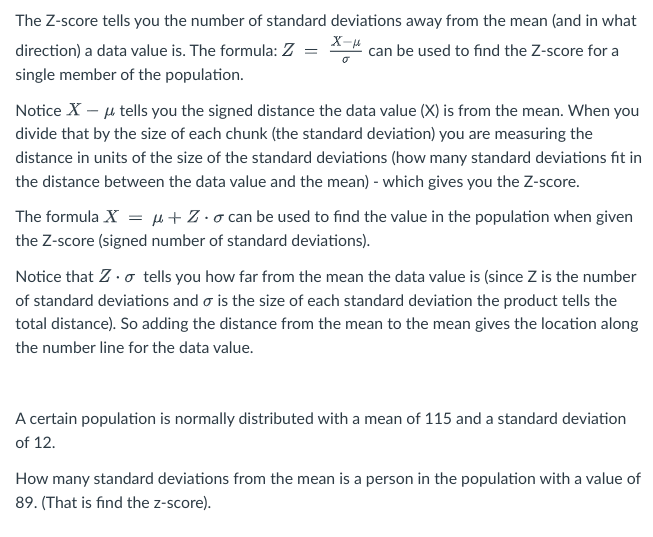The Z-score tells you the number of standard deviations away from the mean (and in what direction) a data value is. The formula: Z X can be used to find the Z-score for a single member of the population. Notice X - μ tells you the signed distance the data value (X) is from the mean. When you divide that by the size of each chunk (the standard deviation) you are measuring the distance in units of the size of the standard deviations (how many standard deviations fit in the distance between the data value and the mean) - which gives you the Z-score. The formula X = μ+Z-o can be used to find the value in the population when given the Z-score (signed number of standard deviations). Notice that Z. σ tells you how far from the mean the data value is (since Z is the number of standard deviations and o is the size of each standard deviation the product tells the total distance). So adding the distance from the mean to the mean gives the location along the number line for the data value. A certain population is normally distributed with a mean of 115 and a standard deviation of 12. How many standard deviations from the mean is a person in the population with a value of 89. (That is find the z-score).
The Z-score tells you the number of standard deviations away from the mean (and in what direction) a data value is. The formula: Z X can be used to find the Z-score for a single member of the population. Notice X - μ tells you the signed distance the data value (X) is from the mean. When you divide that by the size of each chunk (the standard deviation) you are measuring the distance in units of the size of the standard deviations (how many standard deviations fit in the distance between the data value and the mean) - which gives you the Z-score. The formula X = μ+Z-o can be used to find the value in the population when given the Z-score (signed number of standard deviations). Notice that Z. σ tells you how far from the mean the data value is (since Z is the number of standard deviations and o is the size of each standard deviation the product tells the total distance). So adding the distance from the mean to the mean gives the location along the number line for the data value. A certain population is normally distributed with a mean of 115 and a standard deviation of 12. How many standard deviations from the mean is a person in the population with a value of 89. (That is find the z-score).
Mathematics For Machine Technology
8th Edition
ISBN:9781337798310
Author:Peterson, John.
Publisher:Peterson, John.
Chapter29: Tolerance, Clearance, And Interference
Section: Chapter Questions
Problem 16A: Spacers are manufactured to the mean dimension and tolerance shown in Figure 29-12. An inspector...
Related questions
Question

Transcribed Image Text:The Z-score tells you the number of standard deviations away from the mean (and in what
X-μ
can be used to find the Z-score for a
direction) a data value is. The formula: Z
single member of the population.
Notice X - μ tells you the signed distance the data value (X) is from the mean. When you
divide that by the size of each chunk (the standard deviation) you are measuring the
distance in units of the size of the standard deviations (how many standard deviations fit in
the distance between the data value and the mean) - which gives you the Z-score.
The formula X = μ+Z-o can be used to find the value in the population when given
the Z-score (signed number of standard deviations).
Notice that Z. tells you how far from the mean the data value is (since Z is the number
of standard deviations and o is the size of each standard deviation the product tells the
total distance). So adding the distance from the mean to the mean gives the location along
the number line for the data value.
A certain population is normally distributed with a mean of 115 and a standard deviation
of 12.
How many standard deviations from the mean is a person in the population with a value of
89. (That is find the z-score).
Expert Solution
This question has been solved!
Explore an expertly crafted, step-by-step solution for a thorough understanding of key concepts.
Step by step
Solved in 2 steps

Recommended textbooks for you

Mathematics For Machine Technology
Advanced Math
ISBN:
9781337798310
Author:
Peterson, John.
Publisher:
Cengage Learning,

Mathematics For Machine Technology
Advanced Math
ISBN:
9781337798310
Author:
Peterson, John.
Publisher:
Cengage Learning,